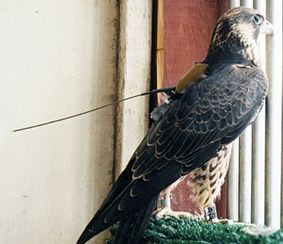Since the recovery of the anatum Peregrine Falcon began, much has been learned about this endangered subspecies. However, one mystery which remains largely unexplored is the migratory habits of the eastern North American peregrine population. In an attempt to learn more about this, the Canadian Peregrine Foundation has launched Project Track-'em, its most expensive and scientifically important undertaking to date.
Satellite tracking of peregrine falcons is not new. The Peregrine Fund, widely recognized as leaders in the North American peregrine recovery efforts, has studied hundreds of peregrines in this manner over the years, including many juveniles. Aside from learning much about the migratory patterns of central and western North American peregrine falcons, they have reached the conclusion that satellite transmitters appear to have no bearing on the flying and hunting behaviour of the birds, or the reproductive success of the peregrines wearing them.
However, other important questions remain unanswered. In Ontario, many of the territorial adults no longer migrate in the winter. Yet each fall, the young of the year disappear from their home ranges, presumably to head south. Unfortunately, few of these young peregrines are ever reported again. Is this because they are dying during their first winter, or because they are going to places where they are either not being seen or not being reported? Satellite tracking will help us begin to answer these questions, and the outcome will have important management implications for peregrine falcons, and possibly also for other birds.
This photograph illustrates how the backpack transmitter we are using is mounted on a peregrine. This is Lincoln from Guelph inside the hack box just after having the transmitter attached to him in August '99. (Photo by Marcel Gahbauer) |
|
The transmitters we are using look like a narrow matchbox with a flexible antenna coming out of the back end. They are worn by the bird like a backpack, attached with a harness that goes under the wings and is held in place by a small patch on the breast. The male transmitter weighs only 20 grams and the female transmitter (with a larger battery and a longer transmission life) only 30 grams, or only around 3 percent of the weight of the bird wearing it. This has been demonstrated to be of negligible consequence to the bird. |
In 1999/2000 the Canadian Peregrine Foundation deployed four satellite transmitters. The tracked were Rouge, Eco, and Nate (from Richmond Hill, Ontario), and Lincoln (from Guelph, Ontario). Five more birds were monitored in 2000/2001: Adelaide (Toronto), Magellan (Etobicoke), Nate (Mississauga), Maryann (Rochester), and Pinnacle (Baldwin Mills). For the 2001/2002 season, eight more birds are being equipped with satellite transmitters - see the 2001/2002 overview for details.
Please see the Project Track-'em home page for the many important partners and sponsors supporting this research.
Click here to go to the 1999-2000 Project Track'em page
Click here to go to the 2000-2001 Project Track'em page
Click here to go to the 2001-2002 Project Track'em page
Click here to go to the 2002-2003 Project Track'em page
Click here to go to the 2003-2004 Project Track'em page
© Canadian Peregrine Foundation
